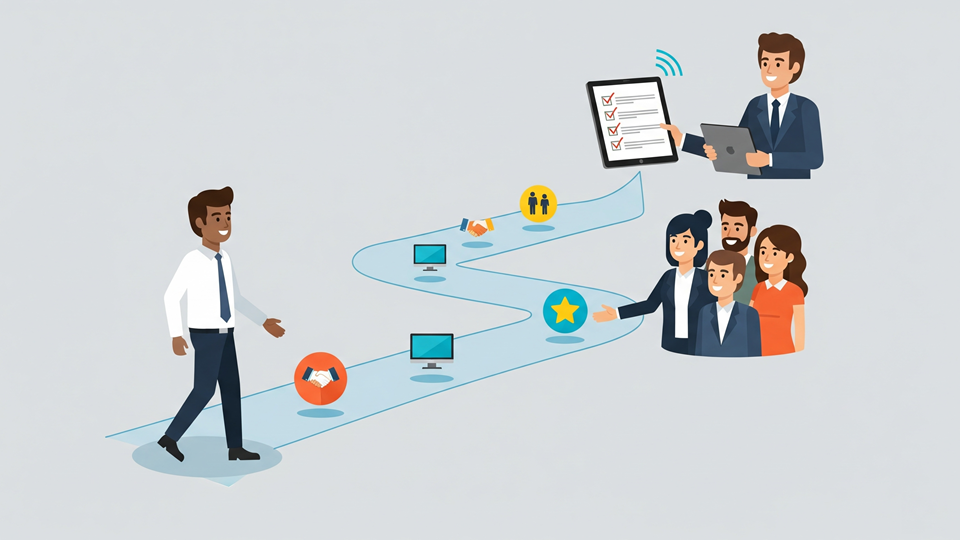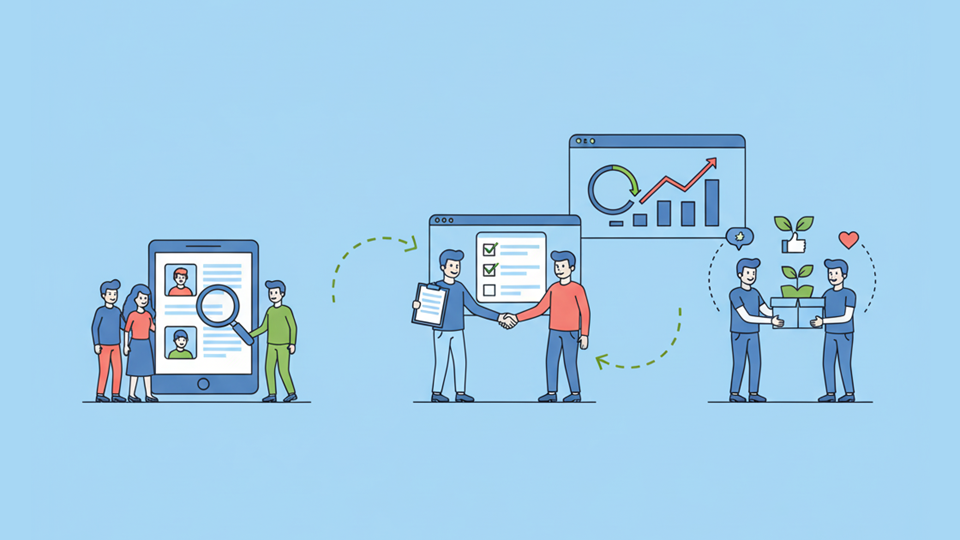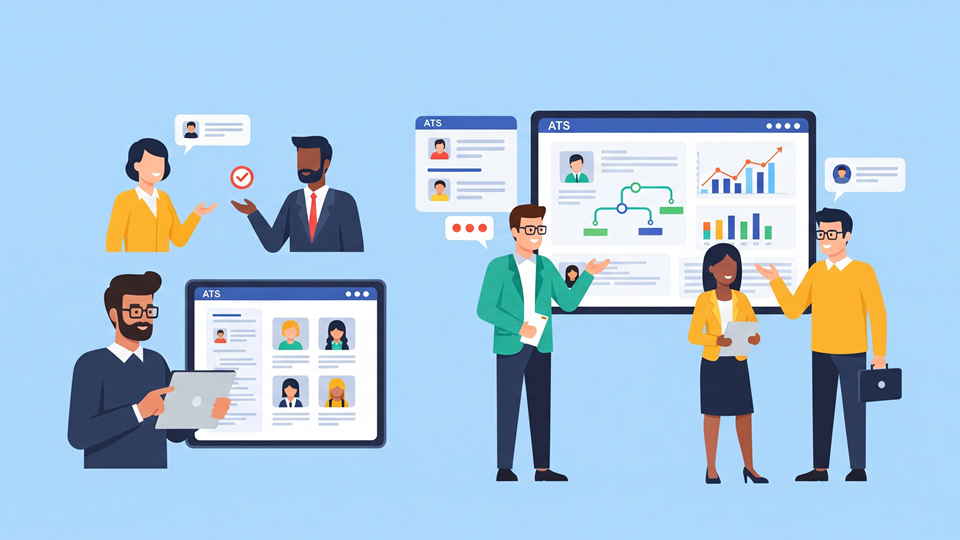Introduction
The hiring process does not end when a candidate signs their offer letter. The real challenge begins with onboarding, where first impressions can shape engagement, productivity, and long-term retention. A well-designed onboarding journey bridges recruitment and integration, helping new hires feel confident, connected, and motivated from the first day. In fact, organizations with structured onboarding programs improve new hire retention by over 80% and boost productivity by more than 70% in the first months.
The Connection Between Recruitment and Onboarding
Recruitment sets expectations, while onboarding delivers on them. When the two processes align, candidates experience consistency, transparency, and trust. The journey should begin even before day one, during the preboarding phase, when communication and preparation ensure a smooth transition.
Preboarding as an Extension of Recruitment
Once a candidate accepts an offer, maintain communication through personalized messages, welcome guides, or team introductions. Sending a short video from their future manager or a digital welcome package can make a strong impression. This approach continues the candidate experience seamlessly into the employee journey.
Why Integration Matters
When onboarding aligns with the recruitment process, candidates better understand the company culture, role expectations, and performance goals. This prevents disconnection and reinforces the positive perception formed during the hiring stage.
Core Elements of an Engaging Onboarding Journey
1. Clear Communication
Transparency about timelines, resources, and objectives reduces anxiety for new hires. Share a schedule for their first week, introduce their team members, and clarify initial tasks. Providing early clarity helps employees feel prepared and valued.
2. Personalized Experience
Each new hire is unique, with different motivations and learning styles. Customize the onboarding flow to match their role, seniority, and location. For example, sales hires might start with product training and client scenarios, while developers focus on technical setups and codebase orientation.
3. Culture and Values Integration
Culture should not be a slide in a presentation but a lived experience. Encourage participation in virtual coffee chats, mentorship programs, or company events to reinforce values and build community. A sense of belonging increases engagement and accelerates adaptation.
4. Technology-Enabled Onboarding
Digital platforms streamline the process by centralizing documentation, progress tracking, and communication. Automating repetitive steps, such as document submission and task reminders, allows HR teams to focus on personalization. For instance, onboarding software can send reminders for goal reviews or feedback sessions automatically.
Designing the Journey: Step-by-Step
Step 1: Define Objectives
Start with a clear purpose. Is your goal to reduce time to productivity, improve engagement, or strengthen cultural alignment? Defining measurable objectives helps evaluate success later. For example, measure how quickly new hires complete their first project or reach performance milestones.
Step 2: Map the Experience
Create a timeline that covers preboarding, the first week, first month, and first 90 days. Include touchpoints such as orientation, check-ins, and goal reviews. Mapping ensures a consistent and well-paced journey for every new hire.
Step 3: Collaborate Across Teams
Effective onboarding involves multiple stakeholders, not just HR. Involve hiring managers, team leads, and mentors in defining content and supporting new hires. Managers play a key role by setting expectations and providing feedback early on.
Step 4: Integrate Learning and Development
Training is most effective when it connects to real work. Blend formal learning with hands-on practice. For example, after a session on company tools, have new hires apply them to a small task. Continuous learning drives long-term engagement and confidence.
Measuring Success
Quantitative Metrics
- Time to Productivity: How quickly new hires reach expected performance.
- Retention Rate: Percentage of hires staying beyond six months.
- Engagement Scores: Survey results showing satisfaction and motivation levels.
Qualitative Feedback
Beyond numbers, gather feedback through one-on-one interviews or surveys. Ask new hires what worked well, what felt confusing, and what could improve. Listening helps refine the experience continually.
Examples of Effective Onboarding Programs
Example 1: A Remote-Friendly Approach
A software startup with distributed teams created a virtual onboarding hub with pre-recorded videos, interactive tutorials, and a buddy system. New hires could explore at their own pace, connect with peers, and ask questions through integrated chat. Engagement scores rose by 35% within three months.
Example 2: A Role-Specific Journey
A mid-sized marketing agency built tailored onboarding paths for different roles. Creative staff joined workshops on brand tone, while account managers received client interaction training. The result was faster integration and stronger cross-team collaboration.
Common Onboarding Mistakes to Avoid
- Information Overload: Bombarding new hires with too much information too soon can cause stress and confusion.
- Lack of Follow-Up: Onboarding should extend beyond the first week. Continuous check-ins are essential to maintain engagement.
- Ignoring Feedback: Not collecting or acting on feedback leads to repetitive mistakes and disengagement.
How Technology Enhances Engagement
AI-driven onboarding tools help personalize the process by analyzing employee data and recommending tailored learning paths. They can also automate scheduling, reminders, and progress tracking. Integrated systems provide a unified experience for HR, managers, and new hires alike.
For example, connecting your Applicant Tracking System (ATS) with your onboarding platform ensures a seamless handover from recruitment. Candidate profiles, interview notes, and offer details automatically flow into the onboarding workspace, reducing manual effort and ensuring data consistency.
Building Engagement from Day One
Encourage Early Wins
Assign manageable tasks early so new hires can feel productive quickly. Small achievements build confidence and momentum. Celebrating these wins reinforces motivation and belonging.
Foster Connection
Encourage team introductions, mentorships, and informal communication channels. Feeling connected from the start promotes loyalty and psychological safety, both crucial for engagement.
Reinforce Purpose
Help new hires see how their role contributes to the company mission. When people understand the impact of their work, they are more likely to feel committed and engaged.
Conclusion
An engaging onboarding journey begins before day one and extends far beyond the first week. By aligning it with the recruitment process, personalizing experiences, and using technology to streamline tasks, companies can create lasting engagement and higher retention. Zamdit, as a modern Applicant Tracking System, helps organizations build that seamless bridge between hiring and onboarding, ensuring every candidate transitions into a motivated and connected employee from day one.





